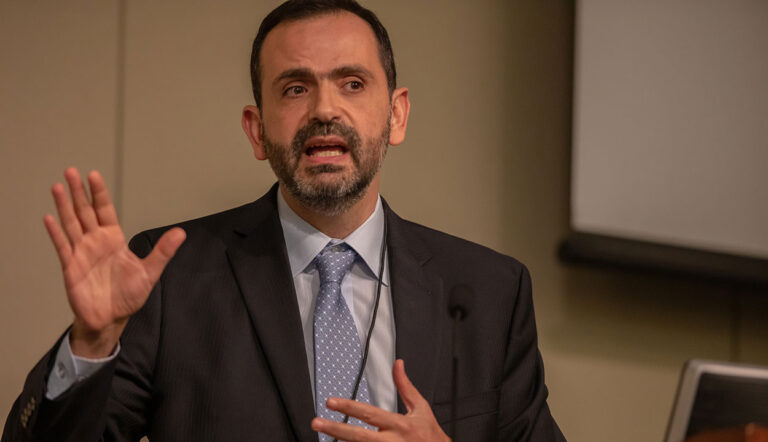Part 1: To upgrade performance quickly, a coach can enhance your forced focus.
In today’s world of increased performance demands and extreme busyness, most leaders are underperforming.
Leading with Emotional Intelligence (EI) helps upgrade your performance by integrating self-skills and developing talent skills to be your best in the moment.
Research from Blessing White Consulting found that the top three leadership skills for the future were: 1) communication, 2) collaboration, and 3) coaching. These are all a part of the EI competency model.
They stated: “If communication skills are the foundation of a leader’s future home, collaboration and coaching create the ground floor. Without a strong foundation of trust and communication, leaders run the risk of directing or deciding instead of collaborating and coaching. Employees will be quick to see this, and despite leaders’ good intentions, fail to inspire and empower their teams to the performance they seek.”
Key Leadership Research
- The manager has a key role in the organization. Gallup has found that managers have 70 percent influence over the climate of their team.
- Sixty percent of employees who left their job said the manager was the reason.
- Turnover has cost organizations $223 billion (Blessing White, 2018).
- Good to great boost: By increasing the number of high-performing leaders, the organization gains great strength… it is tempting to fix low performing leaders, but the greatest gain appears to come by helping more leaders become truly great. Leaders in the top 5 percent had 76 percent of their employees highly committed, where leaders at the 90 percent had 54 percent of their employees highly committed. (Zenger and Folkman 2020)
So a leader considered in the top 5 percent versus the top 10 percent increases employee commitment by 22 percent. That is a huge difference when many can think that the top 10 percent is good enough.
Just like in professional sports, corporate leaders can get a boost and be even better with focused time devoted to their craft with executive coaching.
Coaching can be the quickest way for leaders and managers to manage complexity and improve their communication, collaboration, and coaching skills for the future.
What Is a Coach?
A coach is a thinking partner who works for you and with you to help you reach your best vision for yourself. These are the goals that you want for yourself and think about all the time. The boosting components a coach brings are: 1) A depth of thought to what you think is important; 2) the resources and tools to reach your goals; 3) the motivation and accountability for what you want to accomplish. Coaching encourages a “forced focus” on what is most important to you versus the constant distraction of the urgent.
After 25 years of executive coaching and integrating Emotional Intelligence strategies with top executives and emerging leaders, below are the main reasons why every leader could use coaching.
Why Hire a Coach:
1. Coaching works. You will be a better leader. Here is what we know from the research:
- Ninety-eight percent of coaching clients said their coach “provided practical, realistic, and immediately usable input” and helped them “identify specific behaviors that would help me achieve my goals.” (Center for Creative Leadership study, 2016)
- Strengths are maximized, and research has shown that 66 percent of those receiving effective coaching report a positive impact on their performance and job satisfaction. (BlessingWhite Consulting, 2015)
- Nearly two‐thirds who received coaching said it had a significant impact on their performance and job satisfaction. (BlessingWhite Consulting, 2015)
- 88 percent of managers said coaching helps them achieve their goals. (BlessingWhite Consulting, 2015)
- A 2013 study by Anthony Grant found that executives who received coaching experienced effects that transferred over into the executives’ family life, including heightened work-life balance and improved relationships with family members.
- All signs indicate that executive coaching is a sound investment. Studies report an impressive ROI of 500-800 percent. A study conducted by MetrixGlobal LLC, for example, reported an ROI of 689 percent associated with executive coaching (and this finding accounted for the entire cost of coaching, including the opportunity costs associated with the time leaders spent not on the job in coaching sessions).
- Citing similar results, the International Coach Federation (ICF) has presented a body of research demonstrating that coaching tends to generate an ROI of between $4 and $8 for every dollar invested. (Greiner, 2018)
2. You have blind spots. We all have them, but if you don’t know what they are, you will continue to undermine your success. Marshall Goldsmith is one of the top executive coaches with Fortune 100 executives. In his research with executives, he says 70 percent of people think they are in the top 10 percent. We all think we are better drivers, cooks, and leaders than we may really be. You don’t know what you don’t know. In some of the organizational literature, this is called “Unconscious Incompetence.”
Executive coaches use validated leadership assessments, 360-degree feedback, and interviews with stakeholders to bring to light others’ perceptions of you. The gap between your perceptions and others’ can establish your blindspots.
This gap can result in some of the hardest conversations for a coach and coachee. A leader says, “I think I have empathy, good problem-solving skills, and good interpersonal relations.” The coach has data on how other people see them and may say, “That is different than how your boss or direct reports see you, let’s look at their perception and talk about the gaps.”
I had a leader who was an ex-Navy Seal, who took a 360-degree assessment, and his self-report had him higher on every competency than did his team or manager. Ouch! That was a challenging conversation to hold the tension and come up with effective strategies that he could accept and focus on.
3. You get less feedback. The higher up you are in the organization, the less feedback you get. As leaders move up the corporate ladder, there is less feedback they get from others in the organization for many reasons. Their direct reports are afraid to give honest and direct feedback for fear of retribution and how that impacts their reviews.
The leader’s boss has high expectations, and it is common only to give feedback if there was a mistake or complaints.
So senior leaders don’t get the feedback they need to continually improve. A coach can not only give you feedback but also help integrate the feedback for specific actions.
4. Change is hard: People want to resist it. In every organization, a major challenge is change, whether it is changing a personal behavior or helping your team deal with constant change. Most leaders are inundated in change scenarios.
Getting people to accept change is a leadership challenge. Coaches can bring best practices on leading change, focusing on behavior change using neuroscience, the psychology of motivation, and performance research to the leader.
5. You are on autopilot and easily distracted. Most of us operate on autopilot much of the time. We take short cuts rather than thinking hard or long about things. Working on your leadership entails taking a hard look at your capabilities and getting off automatic to be more intentional, have a clear focus, and make great decisions.
Researchers tell us we operate out of our habits about 95 percent of the time. If you had the time, what would be your best focus? Coaching is a “forced focus” to stay with what’s important.
There are times I know leaders are not thinking or focusing much on their development or their direct reports unless they are in a coaching conversation. We know that we are interrupted almost every three minutes, and 44 percent of the time, we do it to ourselves. (Mark, 2006) Autopilot and the tyranny of the urgent rule the day and leaders’ focus.
Blessingwhite (2018) Tomorrow’s leaders today found the most valued leadership actions are: communicating effectively at all levels, coaching and developing the team, developing and executing the strategy, and building effective relationships with team members.
6. You tell rather than ask, as it is quicker and more efficient. In the desire for speed, efficiency, and alignment, leaders easily fall into telling their direct reports what to do versus asking or dialoguing with them.
This is the manager’s default. It is the path of least resistance and ensures more certainty for the leader. The unexpected results for the employees can be feeling undervalued, insulted, or put down for their ideas.
One of Gallup’s Q12 questions that lead to more engagement and high performing is answering, “My opinion seems to count.”
Ask and Drain Before You Tell and Fill
The direct report has a bucket full of ideas, and so do you as the leader. It is best to ask and drain their bucket of ideas first before you tell and fill from your bucket. Then individuals feel heard, and it gives you more time to think, and when you are ready, you can deliver a better solution.
Asking your direct reports their thoughts first:
- Builds rapport
- Increases the quality of decisions
- Gets more buy-in for the decisions
- Empowers the employees
- Trains them to really think
A coach can help you focus on strategies to ask the right questions and do it in a constructive way that empowers others.
If the three key leadership skills for the future are communication, collaboration, and coaching, an Executive Coach can help you get better at all of these skills quickly.
There are six more reasons why leaders need coaching, which are elaborated in Part 2 of this series. Click here: http://staging.vitalsignsvitalskills.com/6-more-reasons-why-all-leaders-need-coaching/
References
Blessingwhite (2018) Tomorrow’s Leaders Today, www.blessingwhite.com
BlessingWhite Consulting, (2015) Performance Management Assess or Unleash, www.blessingwhite.com
Boyatzis, R. Smith, M. and van Oosten, E. (2019) Helping People Change: Coaching with Compassion for Lifelong Learning and Growth. Boston, MA.: Harvard Business Review Press
Eurich, Tasha, (2017) Insight: The Surprising Truth about How Others See Us, How we see Ourselves, and Why the Answers Matter More Than We Think. New York: Currency
Greiner, N. (2018) Making the Business Case for Coaching. Association or Talent Development Article, August 29, 2018
Grant, A.M. (2008) Workplace, Executive and Life Coaching: An Annotated Bibliography from the Behavioural Science Literature (July 2008), Coaching Psychology Unit, University of Sydney, Australia
Goldsmith, M. with Reiter, M. (2015) Triggers: Creating Behavior That Lasts–Becoming the Person You Want to Be, NY; Crown Publishing Group
“Leadership and Emotional Intelligence: The Keys to Driving ROI and Organizational Performance”, (2013) Human Capital Institute
Gallup. Inc (2015) State of the American Manager Report. Gallup, Inc. Publishing
Gallup Report: “What Separates Great Managers From the Rest,” May 12, 2015 Gallup http://www.gallup.com/businessjournal/183098/report-separates-great-managers-rest.aspx
Mark, Gloria (2006) Gallup Business Journal, June 8
Nelson, B (2012) 1501 Ways to Reward Employees, NY: Workman Publishing
Nadler, R. (2011) Leading with Emotional Intelligence: Strategies for Building Confidant and Collaborative Star Performers NY: McGraw-Hill
Nadler, R. (2011) Leadership Keys, Santa Barbara: Psyccess Press
Stawiski, S. Belzer, M. and Saas.R.G. (2016) Building the Case for Executive Coaching. Center for Creative Leadership
Society of Human Resource Management, “Toxic Workplace Cultures Hurt Workers and Company Profits,” September, 2019
Useem, J. (2017) Atlantic, Power Causes Brain Damage, July/August





